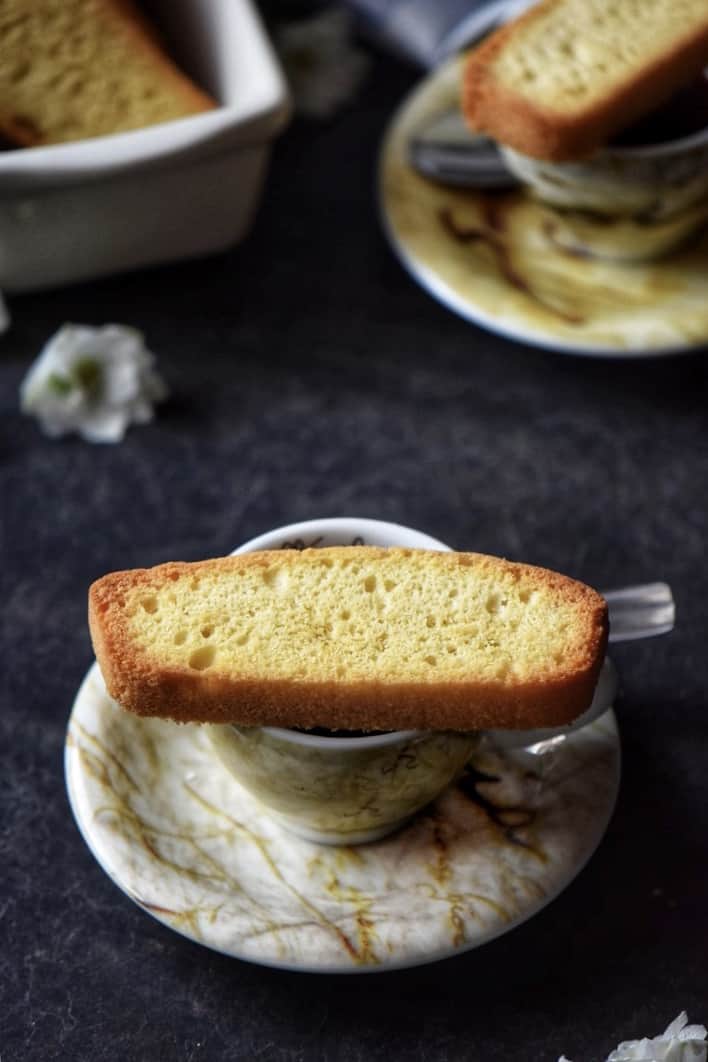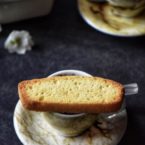Biscotti are the traditional, authentic, Italian cookie. Enjoy authentic anise biscotti with tea, espresso or a glass of milk.
I think it’s time for a classic biscotti recipe. It really doesn’t get any easier than this Authentic Italian Anise Biscotti.
A recent conversation with a colleague of mine reminded me that I have a wonderful biscotti recipe with no nuts. That’s right, no nuts! The perfect recipe for anyone with nut allergies. This type of biscotti recipe can sometimes be referred to as “anise toast”. If the name sounds familiar, you might be thinking of the commercial brand made by Stella D’oro. The next logical question you might have would probably be if a homemade version is any good, right?
Well, these Italian Anise biscotti are not too sweet, easy to make, slightly crunchy and crumbly. If you add more anise than recommended, the biscotti will even get a sort of liquorice-type taste to it. It truly is one of my all-time favourites and I can’t believe I didn’t think of sharing it before today. Are they good? Yeah, they’re amazing!
There are several ways to incorporate the liquorice flavour in your biscotti. You can use Sambuca or Anisette liqueur; you can use the anise seed or extract; or you can use anise oil. I usually use the Anisette liqueur. I always have a bottle or two reserved…for baking, of course.
When I make this biscotti recipe, I will usually divide the batter among three loaf pans. You can place this really soft batter directly on your parchment lined baking sheet, but be warned, they will expand to three times their size. Using loaf pans will give the biscotti a little height, which ensures less breakage. As with most biscotti recipe, they are twice baked.
Introduction to biscotti:
Italian Anise Biscotti, also known simply as “biscotti,” which translates to “twice-baked,” are a type of Italian cookie that is baked twice to achieve its characteristic crispy texture. The addition of anise (either as seeds or anise extract) gives these cookies their distinct, licorice-like flavor. They are often enjoyed dipped in coffee, tea, or even wine.
Biscotti history:
The tradition of twice-baking cookies can be traced back to ancient Roman times. The Romans baked their bread twice to extend its shelf life, especially for soldiers and travelers. This concept later evolved into making biscotti in various regions of Italy, with each having its distinct version. Anise became a popular flavoring in certain regions, especially given the plant’s history in the Mediterranean area.
Characteristics:
- Texture: Biscotti are known for their hard and crunchy texture, achieved through the twice-baking process. The first bake sets the cookie, while the second bake dries it out to create the crunch.
- Flavor: Anise biscotti have a pronounced licorice flavor, derived from the anise. Depending on the recipe, this could come from anise seeds or anise extract. Some variations might also include almonds or other nuts to complement the anise flavor.
- Shape: Traditionally, biscotti are shaped into a log during the first bake. After the first bake, the log is sliced into individual cookies, which are then baked again.
Serving Suggestions:
- Italian Anise Biscotti are typically served with a drink for dipping due to their hard texture. Classic pairings include coffee, tea, and Vin Santo (an Italian dessert wine).
- They can be stored in an airtight container for several weeks, which makes them ideal for gifting or enjoying over an extended period.
Biscotti variations:
While anise is a traditional flavor, biscotti come in a wide variety of flavors ranging from almond to chocolate, cranberry, orange, and many more. Different regions of Italy might have their local variations based on available ingredients and local tastes.
Step by Step Guide to Making Authentic Italian Anise Biscotti
-
Preparation:
- Preheat your oven to 350° F (180° C) and ensure the oven rack is positioned in the center.
- For baking, you can either grease and flour three 8.5 x 4.5-inch loaf pans or use a cookie sheet lined with parchment paper. If using non-stick spray, ensure even coverage to avoid sticking.
-
Dry Ingredients Mixture:
- In a medium mixing bowl, start by sifting together the all-purpose flour, baking powder, and a pinch of salt. This not only combines your dry ingredients but ensures there are no lumps.
- Once sifted, set this mixture aside for later.
-
Egg Mixture:
- In a large mixing bowl or using an electric mixer fitted with a whisk attachment, beat the eggs on medium speed until they turn light and frothy. This process should take about 2-3 minutes.
- Gradually add the granulated sugar to the eggs, continuing to whisk for another minute to combine them well.
- Incorporate the vegetable oil along with the vanilla extract and your choice of anise flavoring (extract, seeds, or Anisette liqueur). Continue whisking for another minute to ensure a smooth blend.
-
Combining Dry and Wet Mixtures:
- Slowly introduce your dry ingredient mixture into the egg mixture. Blend until you achieve a homogenous batter without overmixing.
-
Shaping and First Bake:
- Pour the batter evenly into the three prepared loaf pans. If you’re using a cookie sheet, divide the mixture into two roughly equal-sized loaves.
- Bake these in your preheated oven for 20-25 minutes or until they turn golden brown and pass the toothpick test (a toothpick inserted should come out clean).
-
Slicing and Second Bake:
- After removing from the oven, let your biscotti loaves cool for a few minutes. Then, transfer them to a cutting board.
- With a sharp, serrated knife, slice the loaves into cookies about ¼ inch thick (or thicker if you prefer).
- Place these slices on parchment-lined baking sheets, ensuring they don’t overlap.
- Bake the slices for an additional 5-8 minutes. The longer they stay in the oven, the crispier your biscotti will become.
-
Storage:
- Once baked to your desired crispiness, remove the biscotti from the oven and let them cool. Store in an airtight container at room temperature. They can last for a few weeks, though their delightful taste might mean they disappear much sooner!



How to Make Authentic Italian Anise Biscotti
- Total Time: 50 minutes
- Yield: 36 cookies 1x
Description
This step-by-step guide will help you make authentic Anise Biscotti, perfect for dipping into your morning coffee or evening dessert wine.
Ingredients
- 2 cups all-purpose flour
- 2 teaspoons baking powder
- A pinch of salt
- 4 eggs
- 3/4 cup granulated sugar
- 1/2 cup vegetable oil
- 1 teaspoon vanilla extract
- 1 1/2 teaspoon anise extract OR 2 teaspoons anise seed OR 2 teaspoons Anisette liqueur
Instructions
- Preparation:
- Preheat your oven to 350° F (180° C) and ensure the oven rack is positioned in the center.
- For baking, you can either grease and flour three 8.5 x 4.5-inch loaf pans or use a cookie sheet lined with parchment paper. If using non-stick spray, ensure even coverage to avoid sticking.
- Dry Ingredients Mixture:
- In a medium mixing bowl, start by sifting together the all-purpose flour, baking powder, and a pinch of salt. This not only combines your dry ingredients but ensures there are no lumps.
- Once sifted, set this mixture aside for later.
- Egg Mixture:
- In a large mixing bowl or using an electric mixer fitted with a whisk attachment, beat the eggs on medium speed until they turn light and frothy. This process should take about 2-3 minutes.
- Gradually add the granulated sugar to the eggs, continuing to whisk for another minute to combine them well.
- Incorporate the vegetable oil along with the vanilla extract and your choice of anise flavoring (extract, seeds, or Anisette liqueur). Continue whisking for another minute to ensure a smooth blend.
- Combining Dry and Wet Mixtures:
- Slowly introduce your dry ingredient mixture into the egg mixture. Blend until you achieve a homogenous batter without overmixing.
- Shaping and First Bake:
- Pour the batter evenly into the three prepared loaf pans. If you’re using a cookie sheet, divide the mixture into two roughly equal-sized loaves.
- Bake these in your preheated oven for 20-25 minutes or until they turn golden brown and pass the toothpick test (a toothpick inserted should come out clean).
- Slicing and Second Bake:
- After removing from the oven, let your biscotti loaves cool for a few minutes. Then, transfer them to a cutting board.
- With a sharp, serrated knife, slice the loaves into cookies about ¼ inch thick (or thicker if you prefer).
- Place these slices on parchment-lined baking sheets, ensuring they don’t overlap.
- Bake the slices for an additional 5-8 minutes. The longer they stay in the oven, the crispier your biscotti will become.
Notes
Storage: Once baked to your desired crispiness, remove the biscotti from the oven and let them cool. Store in an airtight container at room temperature. They can last for a few weeks, though their delightful taste might mean they disappear much sooner!
- Prep Time: 20 min
- Cook Time: 30 min
- Category: Dolci
- Method: Baking
- Cuisine: Italian
Nutrition
- Serving Size: 1 biscotti
- Calories: 88
- Sugar: 5g
- Sodium: 50mg
- Fat: 4.5g
- Saturated Fat: 0.5g
- Unsaturated Fat: 3.5g
- Trans Fat: 0.015g
- Carbohydrates: 11.23g
- Fiber: 0.22g
- Protein: 1.7g
- Cholesterol: 25g














How delightful. Thanks for your recipe – I would be interested in other Italian recpies you have – I love to cook and bake. Thanks
David